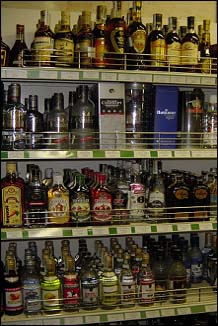 Russian drinks
Russian drinks |
Vodka
Ask anyone about Russia, and soon rather than
later, you will hear them speak about Vodka. In
the beginning, vodka was used as a miracle, pain-relieving
medicine. Now, it is the national beverage of
Russia although beer is rapidly gaining ground
as Moscow's favourite drink.

Vodka is traditionally drunk with "zakuski"
or appetizers of pickled cucumbers, herring and
boiled potatoes. Normally, during family gatherings
and holidays, three shots of vodka are taken.
Russians prefer a lot of it, straight, with no
juice or other mixers added.
It is common to toast and clink glasses for health,
happiness and prosperity.
Tea
Russians are real tea drinkers and generally prefer
tea to coffee. Teahouses are becoming increasingly
popular in the new Russia, including Chinese tea
ceremonies.
Since tea was first brought from Mongolia, it
has become a habit, with Russians drinking three
or even five cups a day. It was traditionally
served with pies, pastries and sugar.
Russians also invented "samovar", a
kind of a metal kettle with a tube inside. You
can boil water by putting pinecones inside the
tube, burning them and letting the water boil.
Kvas
Kvas are a traditional, refreshing Russian drink.
Literally it means "sour beverage".
It has a very specific taste: something between
beer and coca-cola.
Real Russian kvas are made from malt, rye or
wheat flour and are rich in vitamin B. Sometimes
honey is added to sweeten the drink. Kvas were
widely used in folk medicine for curing various
complaints like colds, fever and intestinal diseases.
Kvas were a necessary daily ration in Russian
hospitals because of their nutritious value.
|
You cannot store kvas for a long time because
they tend to ferment. You should never drink bottled
kvas because they usually have nothing to do with
real, homemade kvas. During soviet times, kvas
were sold from huge barrels in the street and
there was always a queue, especially in hot weather.
Kvas are not widespread anymore because most
of the traditional recipes were lost. Fortunately,
you can still find them in Russian restaurants.
 Russian Food
Russian Food |
Russians like to eat and eat a lot. If you are
a guest you will most likely be offered whatever
is in the house. A lot of meat, fish, dairy products,
rye grains, wheat, mushrooms, potatoes and berries
(in the summer).
Herring and caviar are good as vodka appetizers.
Blinis
Pancakes, or "Blinis", are traditional
Russian fair. There is a pancake week or Maslenitsa,
a religious Slavic holiday before the great fast.
It is also a kind of last week of fatty food before
Lent.
Blinis are baked from leavened batter but with
different flours: buckwheat, wheat, millet, barley,
and pea. True Russian blinis are made from buckwheat
flour that gives them lightness and fluffiness
and they have a pleasant, slightly sour taste.
They are both a main course and a desert, depending
on the filling, and are served with almost anything:
herring, sprats, sour cream, salmon, mashed potatoes,
ham and cheese. As a dessert, blinis are served
with honey, sour cream, milk, butter, jams and
fruit.
Soups
Soups are very important in Russian cuisine. In
winter, a hot, liquid meal is necessary in the
cold climate while in the summer, special types
of soups, like okroshka or svekolnik, are served
cold.
Hot soups include schi, borscht, rassolnik, solyanka,
ukha and different vegetable soups. Schi are sour
cabbage soups with meat and sometimes mushrooms.
Borsch, or beet soup with meat and vegetables,
competes with schi in popularity stakes. It should,
like most Russian soups, be served with sour cream
and chopped greens.
All the soups, in old times, were served in ceramic
pots and eaten with wooden spoons because wooden
spoons do not burn your lips.
|

